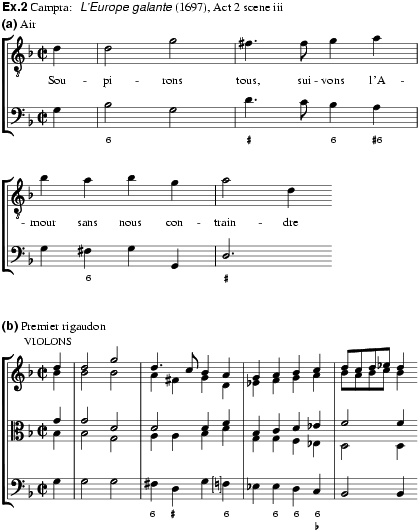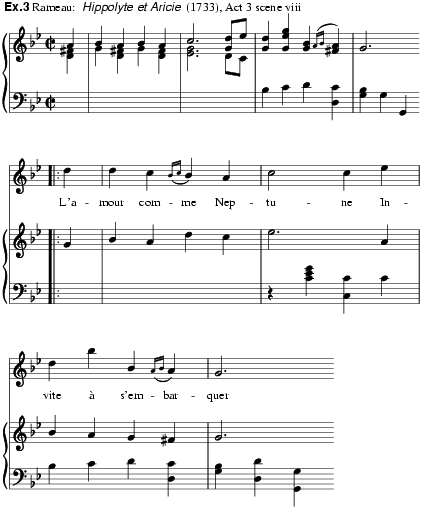
A French folkdance, court dance and instrumental form popular in France and England in the 17th and 18th centuries. As a folkdance it was traditionally associated with southern France, especially the provinces of Vavarais, Languedoc, Dauphiné and Provence, although the term is now used to refer to a wide variety of folkdances from several regions. It is not certain that any of the folk rigaudons were related to the court dance that gained popularity during the reign of Louis XIV. A letter of Mme de Sévigné to her daughter, dated 1673, remarked that ‘Mme Santa Cruz triumphs in the Rigadon’. The popularity of the dance seems to have spread quickly from Paris and Versailles to England and Germany. The rigaudon was especially popular in England, where at least one ‘Rigadoon Royal’ (Little and Marsh, no.7260) was composed by the famous dancing-master Isaac for Queen Anne’s birthday in 1711. It was popular as a social dance for individual couples at balls, as a virtuoso theatre dance and, in simplified form for several couples at once, as one of the many kinds of contredanse.
Like the bourrée, with which it was often compared (Mattheson, Quantz, Rousseau), the rigaudon was a ‘gay’ duple-metre dance in two or more strains characterized by four-bar phrases, usually with an upbeat. Apparently more than one type of rigaudon was known in England as several rigadoons in 6/8 metre appeared in George Bickham’s An Easy Introduction to Dancing (1738). The duple rigaudon was used widely in French ballets and operas, and occasionally somewhat stylized rigaudons were included in instrumental suites, usually after the sarabande movement along with one or more other ‘popular’ dances.
At least 36 choreographies with the title ‘rigaudon’ survive from the early 18th century, some by French choreographers but many by English; most are for social dancing, although a few were evidently for use in the theatre. The rigaudon was a courtship dance and was similar to the bourrée in that each dance represented a particular mixture of steps chosen from among many, including both the pas de bourrée and the fleuret (both characteristic of the Bourrée, involving a bend–rise–step–step combination). At least one step was peculiar to the rigaudon, the pas de rigaudon; this was a group of three movements (hop, step step, jump) done in place during three crotchets of music (Hilton, 226–7). Ex.1 shows the opening phrase of a popular early 18th-century court dance, the Rigaudon de la paix (Little and Marsh, no.7340), as it appeared in Feuillet’s Recüeil de dances (1700). The pas de rigaudon is not shown here, but the second and fourth bars show the use of the fleuret; the combination of the rather restful fleurets in alternation with the activity of the first and third bars creates a rhythmic pattern of motion–repose–motion–repose for the phrase that was typical of the dance.

The heyday of the rigaudon was somewhat later than that of the bourrée. None of Lully’s stage works includes pieces called ‘rigaudon’, although two airs from the pastorale Acis et Galatée (1686) were so labelled elsewhere. Lully’s successors favoured it: Campra included two rigaudons in his ballet L’Europe galante (1697), both simple binary structures. The four-bar phrases begin with a rather static harmony and agogic emphasis on the first two downbeats, with both harmonic and rhythmic activity accelerating to the ends of phrases. Campra’s rigaudon pair follows a brief shepherd’s air that shares the rhythm and form of the dance, and the scene is followed by an instrumental passepied. Ex.2 shows the opening strain of the air and that of the first rigaudon.

A similar rhythmic and harmonic phrase structure appears in the one rigaudon in Desmarets’ opera Circé (1694). Rameau seems to have been particularly fond of the rigaudon, using it in nearly all his operas. In Act 3 of Hippolyte et Aricie (1733) a pair of rigaudons, the first played da capo, frame a sailor’s air in praise of a safe landing; the air borrows the opening rhythm of the second rigaudon. Ex.3 shows the beginnings of both the rigaudon and the air based on it; the harmonic rhythm of this rigaudon is similar to that of Campra’s, beginning with almost no motion and gradually quickening; but the melodic rhythm does not give the agogic emphasis usually accompanying this motion. In the ballet Platée (1744), two passepieds and two rigaudons, both da capo, are played during a dance representing the mingling of peasants and satyrs. Both dramatic uses of the rigaudon confirm Mattheson’s judgment (Der vollkommene Capellmeister, 1739) that the dance evoked a sense of sailing or of pastoral scenes.

Many instrumental rigaudons for harpsichord and ensemble show the characteristic harmonic and melodic rhythms and clear phrase structure of the theatrical dance. Their form was usually either that of successive unrelated strains or, more typically in the 18th century, a rounded binary structure. Ex.4, a rigadoon by Purcell from the second part of Musick’s Hand-maid, shows the adoption of a melodic rhythm like that in the Rameau example above, lacking the characteristic upbeat and long notes at the beginnings of phrases but retaining the harmonic shape of the phrase. A more typical keyboard rigaudon, adopting the rhythmic pattern of the Campra example above, is shown in ex.5, from Gottlieb Muffat’s Componimento musicale (1726). Other keyboard composers who favoured the rigaudon were Elisabeth Jacquet de la Guerre, Charles Daquin, J.C.F. Fischer, Johann Pachelbel, François Couperin and Rameau.


The rigaudon also found its way into Baroque orchestral and chamber music. J.J. Fux’s Concentus musicus (1701) included two rigaudons, one linked with a trio bourrée that works out some rhythmic ideas introduced in the preceding rigaudon. The only significant difference between the rigaudon and the bourrée in this group is in the speed of harmonic change at the beginnings of phrases, for the rigaudon continues to have static openings accelerating to the ends of phrases. As a number of pieces called ‘rigaudon’ (see, for example, two in Muffat’s Componimento musicale) give prominence to the crotchet–minim syncopation thought to be characteristic of the bourrée, and hence to be a distinguishing feature, the harmonic rhythm of rigaudon phrases may prove a useful distinction. Rigaudons were also included in instrumental suites by François Couperin (4e concert royal), Boismortier, Heudelinne, Lalande, Montéclair, J.C.F. Fischer, Telemann, Georg Böhm, J.C. Pez, Georg Muffat and Christoph Graupner, often, as in opera and ballet, followed by a passepied. Although the rigaudon gradually disappeared about the mid-18th century, a few later composers used it, including Grieg (Holberg Suite, 1884), Prokofiev, Saint-Saëns, MacDowell (Air et rigaudon for piano op.49 no.2) and Ravel (Le tombeau de Couperin, 1914–1917).
V. Alford: ‘The Rigaudon’, MQ, xxx (1944), 277–96
P. Nettl: The Story of Dance Music (New York, 1947)
W. Hilton: Dance of Court and Theater (Princeton, NJ, 1981/R)
B. Mather: Dance Rhythms of the French Baroque (Bloomington, IN, 1987), 287–90
M. Little and C.Marsh: La danse noble: an Inventory of Dances and Sources (Williamstown, MA, 1992)
F. Lancelot: La belle dance: catalogue raisonné (Paris, 1996)
MEREDITH ELLIS LITTLE